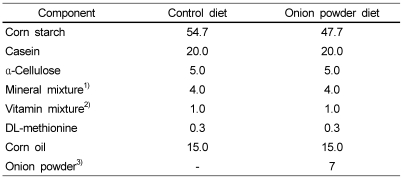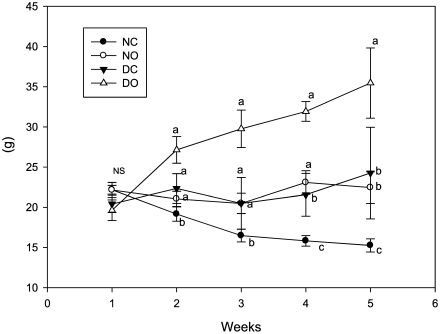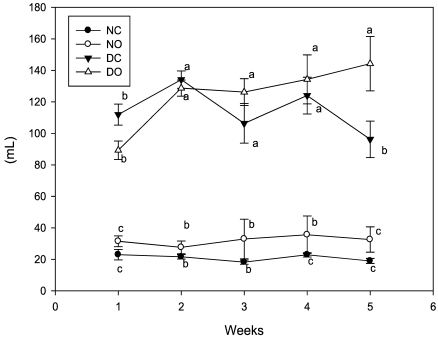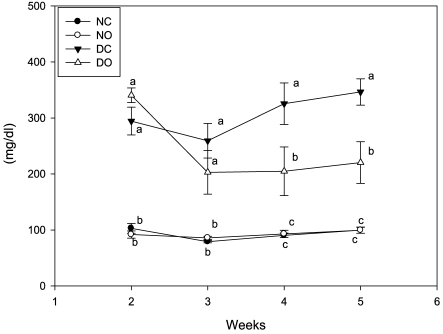Abstract
This study examined the anti-diabetic effect of onion (Allium cepa. Linn) in the streptozotocin (STZ)-induced diabetic rats. Male Sprague-Dawley rats were divided into normal rats fed control diet or supplemented with onion powder (7% w/w) and diabetic rats fed control diet or supplemented with onion powder. Diabetes was induced by a single injection of STZ (60 mg/kg, ip) in citrate buffer. The animals were fed each of the experimental diet for 5 weeks. Blood glucose levels of rats supplemented with onion were lower than those of rats fed control diet in the diabetic rats. Onion also decreased the total serum lipid, triglyceride, and atherogenic index and increased HDL-cholesterol/total cholesterol ratio in the diabetic rats. Glutathione peroxidase, glutathione reductase and glutathione S-transferase activities were high in the diabetic rats compared to normal rats and reverted to near-control values by onion. These results indicate that onion decreased blood glucose, serum lipid levels and reduced renal oxidative stress in STZ-induced diabetic rats and this effect might exert the anti-diabetic effect of onion.
Keywords: Diabetes, onion (Allium cepa. Linn), blood glucose, serum lipid profiles, renal antioxidant enzymes
Introduction
Oxidative stress induced by high glucose concentration plays a central role in complications of diabetes (Medvedeva et al., 2002), though it is not clear yet whether increased oxidative stress has a primary role in the pathogenesis of diabetic complications, or it is simply a consequence of them (Miranda et al., 2007). Oxidative stress induces the production of highly reactive oxygen radicals that are toxic to cells and has been attributed to protein glycation and/or glucose auto-oxidation owing to a hyperglycemic environment (Kesavulu et al., 2001). Oxygen radicals also interact with the lipid bilayer and produce lipid peroxides particularly in cell membranes (Haygaard, 1968; Miranda et al., 2007). Lipid peroxidation of cellular structures is thought to play an important role in atherosclerosis and late complications of diabetes (Kesavulu et al., 2001). Hence, it is likely that a substance known to reduce hyperglycemia and oxidative stress in vivo would reduce progression of cell damage in clinical diabetes. Although controlling blood glucose level is the most important approach in the management of complications of diabetes, abnormalities in lipid metabolism are known to contribute to the pathogenesis of progressive renal disease (Feldt-Rasmussen et al., 1986). Change in the plasma lipid concentration is a frequent complication in patients with diabetes mellitus (Hartnett et al., 2000; Howard et al., 1978; Nikkila & Kekki, 1973; Qureshi et al., 2002). The important role of lipid abnormalities in the pathogenesis of glomerular injury is understood by the almost invariable presence of hyperlipidemia in patients with renal disease (Babu & Srinivasan, 1999; Moorhead, 1991).
Onion (Allium cepa. Linn), commonly used in our daily diet, has been extensively studied for its therapeutic uses. Onion oil has been reported to effectively decrease the lipid levels in experimental animals (Bordia et al., 1975; Bordia et al., 1977). It also has flavonoids, such as quercetin and quercetrin, which have antioxidant and anticancer effects (Carson, 1987; Reddy et al., 1993). Aqueous extraction of onion showed an antithrombotic effect in stretozotocin (STZ)-induced diabetic rats (Jung et al., 2002). However, there is a little information about the effect of onion on the complication of diabetes.
The present study was designed to extend the current information on the hypoglycemic and hypolipidemic effects of onion as well as to determine its effects on renal antioxidant enzyme systems in diabetic rats to establish the mechanism of the anti-diabetic effects of onion.
Materials and Methods
Animals
Weanling male Sprague-Dawley rats (180~230 g) were purchased from Samyouk Animal Center (Seoul, Korea). The animals were housed in the cages under standard conditions (12:12 h light/dark cycle, 50% relative humidity at 21℃) and given free access to a semi-purified diet (Table 1) and water. After 7-d acclimation, experimental diabetes was induced by a single intraperitoneal injection of streptozotocin (Sigma) in citrate buffer at a dose of 60 mg/kg body weight. Blood samples were obtained from the tail vein of the animals at 72 hours after STZ injection and fasting blood glucose levels were determined. Rats with fasting blood glucose levels above 250 mg/dl were used as the diabetic animals. Just after STZ injection, two groups of diabetic rats and two groups of normal rats in parallel were fed experimental diet and maintained on the diets for 5 weeks. The onion-supplemented diet was made of 7% of freeze-dried onion powder added into control diet (Table 1). Food and water consumptions were measured every day and weight gain was measured every week. At the end of 5 weeks, the animals were decapitated after overnight fasting and the kidneys were quickly excised and processed for enzyme assays.
Table 1.
Composition of experimental diets (Unit: g/100 g diet)
1)AIN 76 Mineral mixture. Nutritional Biochemicals, ICN Life Science Group, Cleveland, Ohio Composition of mineral mixture, g/kg mixture ; Calcium phosphate dibasic 500.00 g, Sodium chloride 74.00 g, Potassium citrate monohydrate 220.00 g, Potassium sulfate 52.00 g, Magnesium oxide 24.00 g, Manganous carbonate (43-48% Mn) 3.50 g, Ferric citrate (16-17% Fe) 6.00 g, Zinc carbonate (70% ZnO) 1.06 g, Cupric carbonate (53-55% Cu) 0.30 g, Potassium iodide 0.01 g, Sodium selenite 0.01 g, Chromium sulfate 0.55 g, Sucrose, finely powdered 118.0 g
2)Nutritional Biochemicals, ICN Life Science Group, Cleveland, Ohio Vitamin mixture is composed of; Vit.A acetate (500,000 IU/g) 1.8 g, Vit.D conc. (850.000 IU/g) 0.125 g, α-Tocopherol (250 IU/g) 22.0 g, Ascorbic acid 45.0 g, Inositol 5.9 g, Choline chloride 75.0 g, Menadione 2.25 g, P-Aminobenzoic acid 5.0 g, Niacin 4.25 g, Riboflavin 1.0g, Pyridoxine hydrochloride 1.0 g, Calcium pantothenic acid 3.0 g, Biotin 0.02 g, Folic acid 0.09 g, Vit.B12 0.00135 g, and Dextrose to 1 kg
3)Onion, growing Muan-gun, was sliced and frozen for 24hr at -20℃. The next day, frozen sliced onion was loaded into a freeze-dryer (ilshin Co. Korea). Drying was carried out with a shelf temperature of -35℃ and a chamber pressure of <100 mTorr for 48 h and then the chamber pressure was increased to 200 mTorr. Shelf temperature was held at 0℃ for 4 h. When prepared Diet, grind frozen onion to powder.
Blood glucose and serum lipids
Blood glucose was measured from the blood of all the animals, taken from the tail vein using a kit (Medisense 2, Korea) every week. The concentrations of serum total lipid, total cholesterol, HDL-cholesterol and triglyceride were determined using a commercial kit (Asan, Korea) at the end of the experiment. Atherogenic index and HDL-cholesterol / total cholesterol ratio were calculated from the data.
Antioxidant enzyme activities in kidney
An appropriate portion of kidney was homogenized in ice-cold Tris buffer, pH 7.4. The homogenates were centrifuged at 12,000xg for 20 min at 4℃, then again at 105,000xg for 1hr at 4℃. The supernatant (cytosol) was used for measuring the activities of glutathione peroxidase (Tapple, 1978), glutathione reductase (Carlberg & Mannervick, 1985), and glutathione S-transferase (Habig et al., 1974). Glucose 6-phosphatase activity (Banginski et al., 1983) and TBARS contents were measured in the microsome. Protein content was measured according to the Lowry method (Lowry et al., 1951).
Statistical analysis
All data are expressed as the mean ± SE. The statistical analyses were performed on an SPSS program (version 12). The group comparisons were done using a variance analysis followed by Duncan's multiple range test. Statistical significance was considered at P < 0.05.
Results
Body weight, food intake and water intake
Diabetic rats fed the control diet showed no significant difference in food intake compared to normal rats. However, the food intakes of diabetic rats supplemented with onion were significantly higher than those of other groups (Fig. 1). Diabetic rats showed low body weight gain regardless of diet. Onion increased the feed efficiency ratio in the diabetic rats, even though it was still lower than those of normal groups (Table 2). Water intakes of the diabetic rats were higher than those of the normal rats. Onion did not show any appreciable influence on the water intakes in the diabetic animals (Fig. 2, Table 2).
Fig. 1.
Effect of supplementation of onion on the food intakes in the rats (g/day/rat). Values in the same period with same letter are not significantly different by Duncan's multiple range test (P < 0.05). NC : Normal rats fed control diet, NO: Normal rats fed onion powder diet (7%, w/w), DC: Diabetic rats fed control diet, DO: Diabetic rats fed onion powder diet (7%, w/w)
Table 2.
Effect of onion powder on body weight, food intakes and water intakes in rats
Experimental conditions are same as Fig. 1.
Values are Mean ± SE.
Values within the same row with same letter are not significantly different by Duncan's multiple range test (P < 0.05).
1)Feed efficiency ratio
Fig. 2.
Effect of supplementation of onion on the water intakes in the rats (ml/day/rat). Experimental conditions are same as Fig. 1. Values in the same period with same letter are not significantly different by Duncan's multiple range test (P < 0.05).
Fasting blood glucose and serum lipids
Levels of fasting blood sugar in the diabetic rats were significantly higher than those of the normal rats throughout the experimental period. Blood glucose in the diabetic rats supplemented with onion became lower when the rats had been fed onion for 3 weeks and was significantly lower than that of diabetic rats fed the control diet at the end of experiment (Fig. 3).
Fig. 3.
Effect of supplementation of onion on the fasting blood sugar in the rats. Experimental conditions are same as Fig. 1. Values in the same period with same letter are not significantly different by Duncan;s multiple range test (P < 0.05).
Onion did not affect serum total lipid, triglyceride and HDL-cholesterol in the normal rats. HDL-cholesterol/total cholesterol ratio and atherogenic index of the normal rats were also not affected by onion. Serum total lipid, triglyceride, total cholesterol and atherogenic index of the diabetic rats fed control diet were increased by 235%, 275%, 136% and 146%, respectively compared to normal rats. However, serum total lipid, triglyceride and the atherogenic index of the diabetic rats were decreased by onion and not significantly different from those of normal rats fed the control diet (Table 3). Serum total cholesterol of the diabetic rats was decreased by onion but not significantly different compared to diabetic rats fed the control diet (Table 3).
Table 3.
Levels of serum triglyceride, total lipid, total cholesterol, HDL-cholesterol, LDL-cholesterol, HTR, and atherogenic index in normal and diabetic rats
Experimental conditions are same as Fig. 1.
Values are Mean ± SE.
Values within the same row with same letter are not significantly different by Duncan's multiple range test (P < 0.05).
1)HTR: HDL-cholesterol/Total cholesterol ratio
2)AI: atherogenic index: (Total cholesterol-HDL-cholesterol)/HDL-cholesterol
Renal antioxidant enzymes and TBARS content
Diabetes induced high activities of glutathione peroxidase (GPx), glutathione reductase (GR) and glutathione S-transferase (GST) in the rats fed the control diet (Table 4). Increased activities of these enzymes in the diabetic rats were significantly decreased by onion. TBARS content and glucose 6-phosphatase (G6Pase) activity showed no difference between the control and the diabetic rats.
Table 4.
Renal biochemical parameters in the normal and diabetic rats
Experimental conditions are same as Fig. 1.
Values are Mean ± SE.
Values within the same row with same letter are not significantly different by Duncan's multiple range test (P < 0.05).
Discussion
Streptozotocin (STZ) induced diabetes in animals caused weight loss due to abnormal carbohydrate and lipid metabolism and increased catabolism of protein. For this reason, weight reduction is being used as a marker of diabetes mellitus induced by STZ (Ghosh et al., 1994). In the present study, onion decreased weight loss in the diabetic rats by the increase of feed efficacy ratio. Onion did not show any appreciable influence on the water intakes in the diabetic animals.
Hyperglycemia can induce lipid peroxidation and thereby atherosclerosis (Medvedeva et al., 2002). It also induces gene expression of angiotensinogen in the kidney and insulin receptor resistance (Zhang et al., 2000). In the present study, onion significantly decreased blood glucose in the diabetic rats. Onion might play an important role to prevent complications of diabetes by maintaining blood glucose.
We observed onion lowered serum lipids in the diabetic rats. The lowering effect on serum lipids in the diabetic animals might be associated with a good glucose control by onion. A good glucose control was reported to improve the parameters of serum lipid profile in patients with diabetes mellitus (Medvedeva et al., 2002). Onion itself was also reported to have a serum lipid lowering effect in hyperlipidemic experimental animals (Bordia et al., 1975; Bordia et al., 1977; Carson 1987). Serum lipid lowering effect of onion can be one of the mechanisms of anti-diabetic effects and contribute to the prevention of diabetic nephropathy. Hyperlipidemia is a risk factor for declining kidney function in patients with diabetic nephropathy (Bordia et al., 1975). It was also reported that patients with low serum cholesterol concentration exhibited a lower degree of kidney lesions than those with high serum cholesterol concentration (Mulec et al., 1990).
The increase of free radical mediated-toxicity is well documented in clinical diabetes (Nourooz-Zadeh et al., 1997) and STZ-induced diabetic rats (Wohaie & Godin, 1987). Diabetes-induced changes in antioxidative defense enzyme activities are known to be tissue specific (Irizar & Ioannides, 1995; Obrosova et al., 1998). In the kidney, SOD, GPx, GR, and GST, but catalase, appeared up-regulated in short term diabetes, which is consistent with a number of reports (Irizar & Ioannides, 1995; Kakkar et al., 1997; Mak, 1996). Glutathione related antioxidant enzymes such as GPx, GR, and GST are the most important enzymes of the cellular antioxidant system (Dincer et al., 2002). In the present study, enzyme activities of GPx, GR and GST in the kidneys were increased in diabetic animals. GPx activity might be increased in response to increased oxidative stress. TBARS content showed no difference between the control and the diabetic rats in the present study. It might be correlated to increased GPx activity. Kakkar et al. (1997) reported that increased GPx activity was observed in the 2nd, 3rd, and 4th weeks with progression of diabetes and correlated to the lack of rise in TBARS levels at this period. Most of the diabetes-induced changes were reverted to near normal values by onion in this study. The possibility that modulation of the hyperglycemic status by onion contributed to the amelioration of renal lesions cannot be ruled out. Another possibility is that onion itself acted as an antioxidant and could attribute to the amelioration of free radical induced toxicity in the diabetic kidneys. A variety of sulfur-containing compounds and their precursors are the main compounds, which attribute to the antioxidant activity of Allium plants (Nuutila et al., 2003). In addition to sulfur-containing compounds, onion has a large amount of quercetin, which has antioxidant effects (Jung et al., 2002; Reddy et al., 1993). Therefore, we can conclude that oxidative stress was induced in the kidneys of diabetic animals and effectively prevented by onion.
Footnotes
This study was supported by the Korea Science and Engineering Foundation (KOSEF) through the Food Industrial Technology Research Center (RRC) at Mokpo National University.
References
- 1.Babu PS, Srinivasan K. Renal lesions in streptozotocin-induced diabetic rats maintained on onion and capsaicin containing diets. J Nutr Biochem. 1999;10:477–483. doi: 10.1016/s0955-2863(99)00031-5. [DOI] [PubMed] [Google Scholar]
- 2.Banginski ES, Foa PP, Zak B. Methods of Enzymatic Analysis. 2. New York. USA: Academic Press; 1983. pp. 876–880. [Google Scholar]
- 3.Bordia A, Bansal HC, Arora SK, Singh SV. Effect of essential oils of garlic and onion on alimentary hyperlipidemia. Atherosclerosis. 1975;21:15–19. doi: 10.1016/0021-9150(75)90091-x. [DOI] [PubMed] [Google Scholar]
- 4.Bordia A, Verma SK, Vyas AK. Effect of essential oils of onion and garlic on experimental atherosclerosis in rabbits. Atherosclerosis. 1977;26:375–386. doi: 10.1016/0021-9150(77)90092-2. [DOI] [PubMed] [Google Scholar]
- 5.Carlberg I, Mannervick B. Glutathione reductase. Methods Enzymol. 1985;113:484–499. doi: 10.1016/s0076-6879(85)13062-4. [DOI] [PubMed] [Google Scholar]
- 6.Carson JF. Chemistry and biological properties of onion and garlic. Food Reviews Internationl. 1987;3:71–103. [Google Scholar]
- 7.Dincer Y, Alademir Z, Ilkova H, Akcay T. Susceptibility of gluathione and glutathione-related antioxidant activity to hydrogen peroxide in patients with type 2 diabetes: effect of glycemic control. Clin Biochem. 2002;35:297–301. doi: 10.1016/s0009-9120(02)00317-x. [DOI] [PubMed] [Google Scholar]
- 8.Feldt-Rasmussen B, Mathiesen ER, Deckert T. Effect of 2 years of strict metabolic control on progression of incipient nephropathy in insulin dependent diabetes. Lancet. 1986;2:1300–1304. doi: 10.1016/s0140-6736(86)91433-9. [DOI] [PubMed] [Google Scholar]
- 9.Ghosh R, Mukherjee B, Chatterjee M. A novel effect of selenium on streptozotocin-induced diabetic mice. Diabetes Res. 1994;25:165–171. [PubMed] [Google Scholar]
- 10.Habig WH, Pabst MJ, Jakoby WB. Glutathione S-transferase. J Biol Chem. 1974;249:7130–7139. [PubMed] [Google Scholar]
- 11.Hartnett ME, Stratton RD, Browne RW, Rosner BA, Lanham RJ, Armstrong D. Serum markers of oxidative stress and severity of diabetic retinopathy. Diabetes Care. 2000;23:234–240. doi: 10.2337/diacare.23.2.234. [DOI] [PubMed] [Google Scholar]
- 12.Haygaard N. Cellular mechanisms of oxygen toxicity. Physiological Reviews. 1968;48:311–373. doi: 10.1152/physrev.1968.48.2.311. [DOI] [PubMed] [Google Scholar]
- 13.Howard BV, Savage PJ, Bennion LJ, Bennett PH. Lipoprotein composition in diabetes mellitus. Atherosclerosis. 1978;30:153–162. doi: 10.1016/0021-9150(78)90058-8. [DOI] [PubMed] [Google Scholar]
- 14.Irizar A, Ioannides C. Extrahepatic expression of P450 proteins in insulin-dependent diabetes mellitus. Xenobiotica. 1995;25:941–949. doi: 10.3109/00498259509046665. [DOI] [PubMed] [Google Scholar]
- 15.Jung YS, Kim MH, Lee SH, Baik EJ, Park SW, Moon CH. Antithrombotic effect of onion in streptozotocin-induced diabetic rat. Prostaglandins. 2002;66:453–458. doi: 10.1054/plef.2002.0373. [DOI] [PubMed] [Google Scholar]
- 16.Kakkar R, Mantha SV, Radhi J, Prasad K, Kalra J. Antioxidant defense system in diabetic kidney: a time course study. Life Sci. 1997;60:667–679. doi: 10.1016/s0024-3205(96)00702-3. [DOI] [PubMed] [Google Scholar]
- 17.Kesavulu M, Rao BK, Giri R, Vijaya J, Subramanyam G, Apparao Ch. Lipid peroxidation and antioxidant enzyme status in Type 2 diabetic with coronary heart disease. Diabetes Res Clin Pract. 2001;53:33. doi: 10.1016/s0168-8227(01)00238-8. [DOI] [PubMed] [Google Scholar]
- 18.Lowry OH, Rosebrough NJ, Farr AL, Randall RT. Proteinmeasurement with the folin phenol reagent. J Biol Chem. 1951;193:265–275. [PubMed] [Google Scholar]
- 19.Mak DH, Ip SP, Li PC, Poon MK, Ko KM. Alterations in tissue glutathione antioxidant system in streptozotocin-induced diabetic rats. Mol Cell Biochem. 1996;162:153–158. doi: 10.1007/BF00227543. [DOI] [PubMed] [Google Scholar]
- 20.Medvedeva IV, Pufacheva TA, Dorodneva EF. Influence of glucose control on the main parameters of serum lipid profile and platelet membranes in patients with metabolic syndrome and type 2 diabetes mellitus. Atheroscler Suppl. 2002;3:163. [Google Scholar]
- 21.Miranda M, Muriach M, Almansa I, Arnal E, Messeguer A, Diaz-Llopis M, Romero FJ, Bosch-Morell F. CR-6 protects glutathione peroxidase activity in experimental diabetes. Free Radic Biol Med. 2007;43:1494–1498. doi: 10.1016/j.freeradbiomed.2007.08.001. [DOI] [PubMed] [Google Scholar]
- 22.Moorhead JF. Lipids and progressive kidney disease. Kidney Int Suppl. 1991;31:S35–S40. [PubMed] [Google Scholar]
- 23.Mulec H, Johnson SA, Bjorck S. Relationship between serum cholesterol and diabetic nephropathy. Lancet. 1990;335:1537–1538. doi: 10.1016/0140-6736(90)93090-c. [DOI] [PubMed] [Google Scholar]
- 24.Nikkila EA, Kekki M. Plasma triglyceride transport in diabetes mellitus. Metabolism. 1973;22:1–22. doi: 10.1016/0026-0495(73)90024-3. [DOI] [PubMed] [Google Scholar]
- 25.Nourooz-Zadeh J, Rahini A, Tajaddini-Sarmadi J. Relationships between plasma measures of oxidative stress and metabolic controls in NIDDM. Diabetologia. 1997;40:647–653. doi: 10.1007/s001250050729. [DOI] [PubMed] [Google Scholar]
- 26.Nuutila AM, Puupponen-Pimia R, Aarni M, Marja K, Caldentey O. Comparison of antioxidant activities of onion and garlic extracts by inhibition of lipid peroxidation and radical scavenging activity. Food Chem. 2003;81:485–493. [Google Scholar]
- 27.Obrosova I, Cao X, Greene DA, Stevens MJ. Diabetes-induced changes in lens antioxidant status, glucose utilization and energy metabolism: effect of DL-alpha-lipoic acid. Diabetologia. 1998;41:1442–1450. doi: 10.1007/s001250051090. [DOI] [PubMed] [Google Scholar]
- 28.Qureshi AA, Sami SA, Khan FA. Effects of stabilized rice bran, its soluble and fiber fractions on blood glucose levels and serum lipid parameters in human with diabetes mellitus type I and II. J Nutr Biochem. 2002;13:175–187. doi: 10.1016/s0955-2863(01)00211-x. [DOI] [PubMed] [Google Scholar]
- 29.Reddy AS, Rao CV, Rivenson A, Kelloff G. Chemoprevention of colon carcinogenesis by organosulfur compounds. Cancer Res. 1993;53:3493–3498. [PubMed] [Google Scholar]
- 30.Tapple AL. Glutathione peroxidase and hydroperoxides. Meth Enzymol. 1978;52:506–513. doi: 10.1016/s0076-6879(78)52055-7. [DOI] [PubMed] [Google Scholar]
- 31.Wohaieb SA, Godin DV. Alterations in free radical tissue-defense mechanisms in streptozotocin-induced diabetes in rat: effects of insulin treatment. Diabetes. 1987;36:1014–1018. doi: 10.2337/diab.36.9.1014. [DOI] [PubMed] [Google Scholar]
- 32.Zhang SL, Chen X, Hsieh TJ, Leclerc M, Henley N, Allidina A, Halle JP, Brunette MG, Filep JC, Tang SS, Ingelfinger JR, Chan JS. Hyperglycemia includes insulin resistance on angiotensinogen gene expression in diabetic rat kidney proximal tubular cells. J Endocrinol. 2000;172:333–344. doi: 10.1677/joe.0.1720333. [DOI] [PubMed] [Google Scholar]








